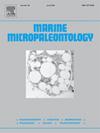Evolutionary, paleoecological and taphonomic aspects of new agglutinated foraminifer Devonodendron scopulum from the Frasnian of Holy Cross Mts, Poland
IF 1.5
4区 地球科学
Q2 PALEONTOLOGY
引用次数: 0
Abstract
Regularly bifurcated tubiform (tree-like) microfossils, although illustrated three decades ago from the Frasnian of the Holy Cross Mts (southern Poland), have not been studied in detail until now. In this paper, the distinctive microproblematic is interpreted as a calcite-cemented agglutinated foraminifer belonging to Devonodendron scopulum sp. et gen. nov., appearing in a major radiation after the Givetian Revolution. Based on the study of isolated three-dimensional specimens, this Devonian species is the best documented of the early branching foraminifera. It resembles living arborescent representatives of the family Schizamminidae (such as Schizammina arborescens and S. andamana), but also the family Dendrophryidae (Psammatodendron arborescens), which has already been reported in the fossil record (Cretaceous; questionable Silurian). However, in light of genetic studies of modern monothalamids, phylogenetic inferences based on such simple morphology are risky. The tree-like branching system of this species suggests erect attached and filter feeding life habit. Devonodendron scopulum shows a pronounced microhabitat selectivity, being dominantly restricted to mid-slope metazoan-microbial mud-mounds. The buildups provided microniches for flourishing a very abundant and diverse calcareous microbiota, including taxa with known (Nanicella) and presumed (Eifeliflabellum) foraminiferal affinities. The environment was characterized by a specific diagenetic setting for the fossilization of micritic-organic tubular tests due to rapid microbially mediated lithification and overwhelming recrystallization processes. As a result, microfossils are largely preserved as stacked homogeneous rhomboidal calcite plates. Many specimens in some sites are actually just coalesced sparry calcite ‘pseudomorphs’ mimicking the original test morphology.
波兰圣十字山Frasnian新凝集有孔虫Devonodendron scopulum的进化、古生态和地语学方面
规律分叉的管状(树状)微化石,虽然在三十年前从圣十字山(波兰南部)的弗拉斯尼安发现,但直到现在还没有被详细研究过。在本文中,这一独特的微问题被解释为一种方解石胶结的有孔虫,属于Devonodendron scopulum sp. et gen. 11 .,出现在Givetian革命后的一次主要辐射中。基于对孤立的三维标本的研究,这个泥盆纪物种是早期分支有孔虫中记录最好的物种。它类似于Schizamminidae科(如Schizammina arborescens和S. andamana)的现存乔木代表,但也类似于已经在化石记录中报道的树科(Psammatodendron arborescens)。可疑的志留纪)。然而,鉴于现代单丘脑的遗传研究,基于这种简单形态的系统发育推断是有风险的。该物种的树状分支系统表明直立附着和滤食的生活习惯。泥盆子具有明显的微生境选择性,主要局限于中坡后生动物-微生物泥丘。这些积累为丰富多样的钙质微生物群提供了微生态环境,包括已知的(Nanicella)和推定的(Eifeliflabellum)有孔虫类群。由于快速的微生物介导的岩化作用和压倒性的再结晶过程,该环境的特点是为微晶有机管状试验的石化提供了特定的成岩环境。因此,微化石大部分以堆积均匀的菱形方解石板的形式保存下来。在一些地点的许多标本实际上只是合并的亮晶方解石“假晶”,模仿原始的测试形态。
本文章由计算机程序翻译,如有差异,请以英文原文为准。
求助全文
约1分钟内获得全文
求助全文
来源期刊

Marine Micropaleontology
地学-古生物学
CiteScore
3.70
自引率
15.80%
发文量
62
审稿时长
26.7 weeks
期刊介绍:
Marine Micropaleontology is an international journal publishing original, innovative and significant scientific papers in all fields related to marine microfossils, including ecology and paleoecology, biology and paleobiology, paleoceanography and paleoclimatology, environmental monitoring, taphonomy, evolution and molecular phylogeny. The journal strongly encourages the publication of articles in which marine microfossils and/or their chemical composition are used to solve fundamental geological, environmental and biological problems. However, it does not publish purely stratigraphic or taxonomic papers. In Marine Micropaleontology, a special section is dedicated to short papers on new methods and protocols using marine microfossils. We solicit special issues on hot topics in marine micropaleontology and review articles on timely subjects.
 求助内容:
求助内容: 应助结果提醒方式:
应助结果提醒方式:


